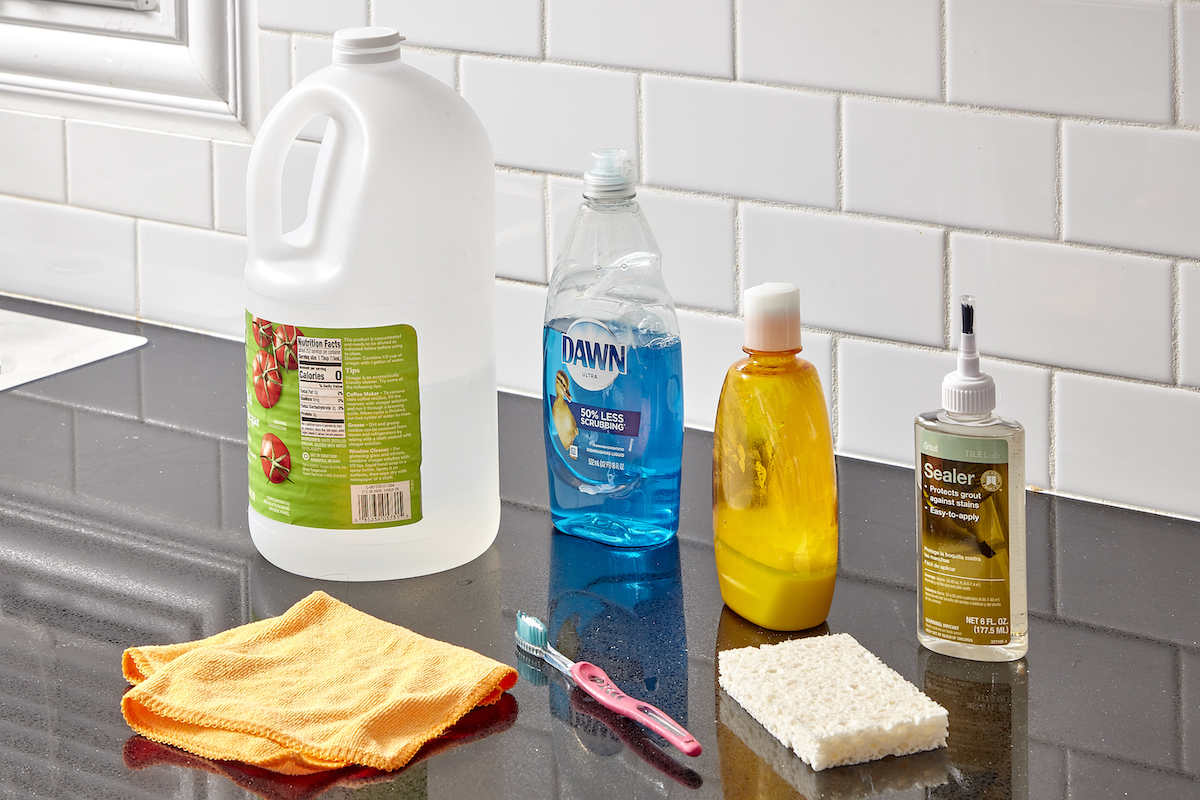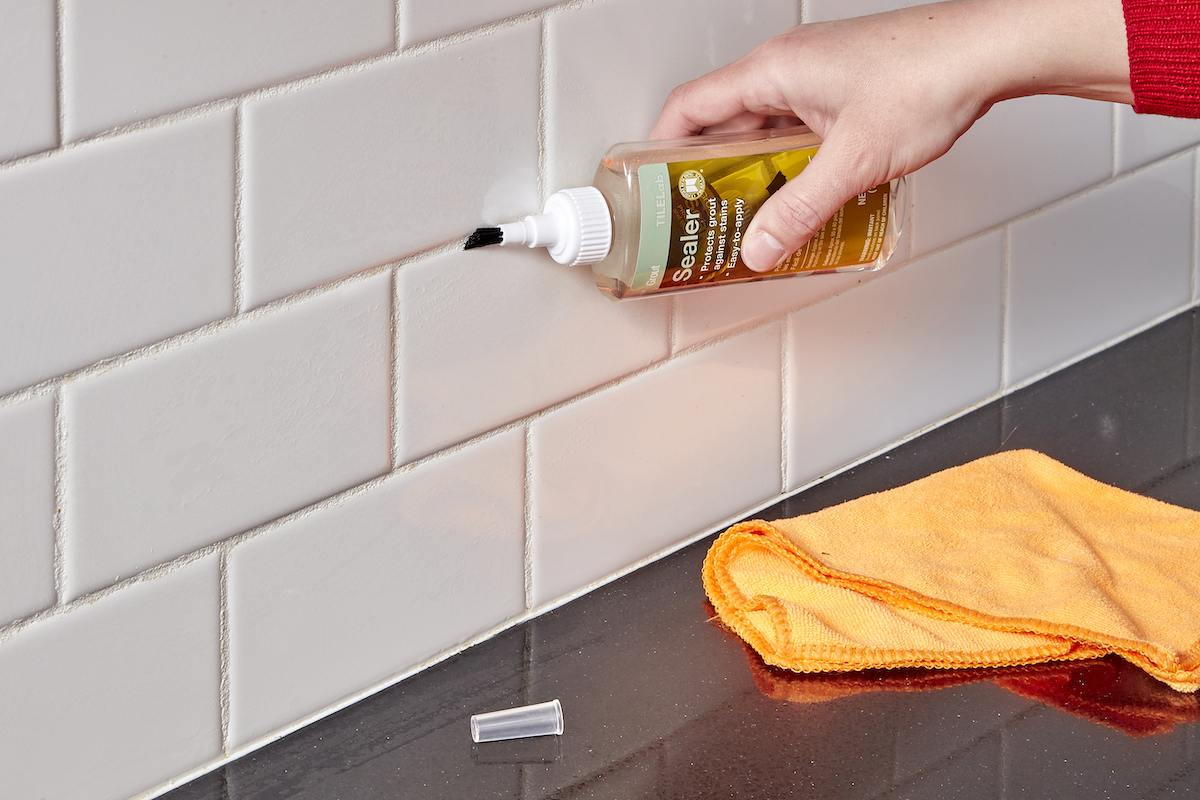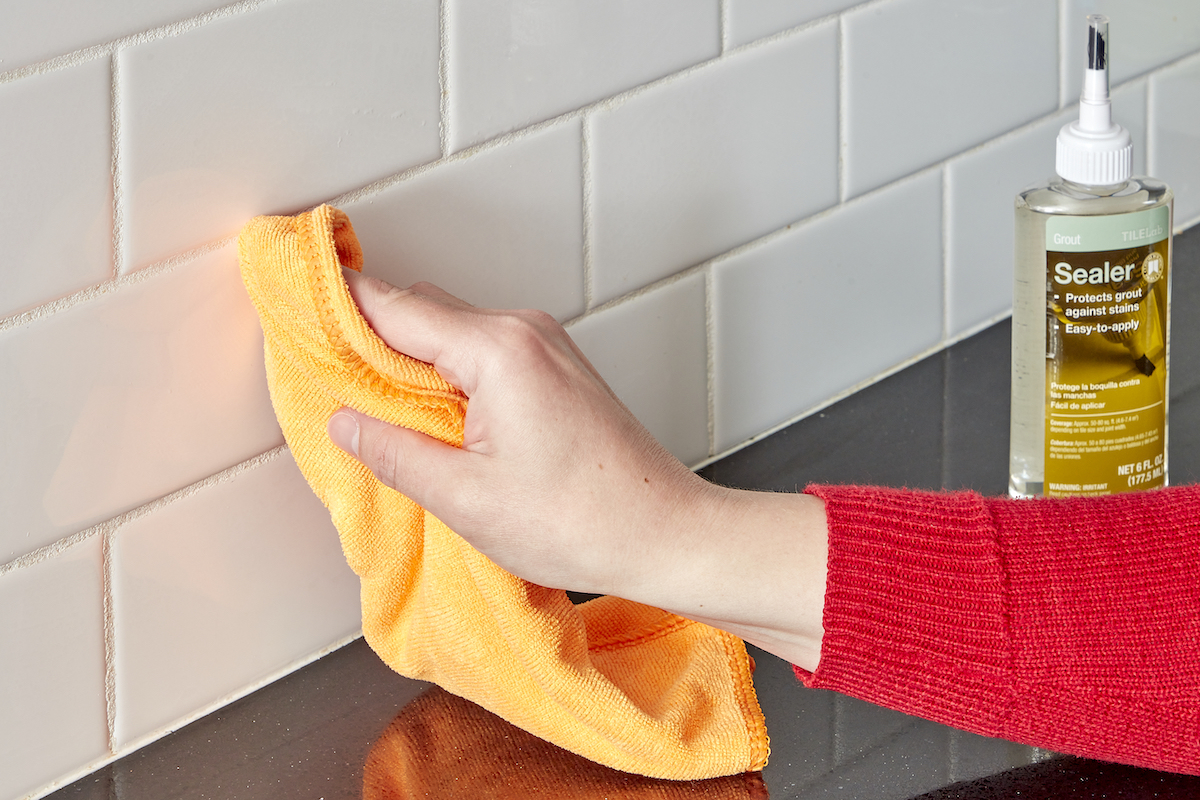

We may earn revenue from the products available on this page and participate in affiliate programs. Learn More ›
Even if you keep your bathroom tiles clean, dirty grout lines can really detract from the look of your tiled floors and walls. Because cement-based grout, whether sanded or not, is porous by nature, substances like oil, grease, and water tend to seep inside and cause ugly discoloration.
The best way to prevent this is to seal your new grout and repeat as needed. You’ll wan to give the sealer a refresh every year or so on a tile floor that doesn’t get wet, and more often for grout in the shower or on the bathroom backsplash. With these instructions, you’ll learn how to seal grout and create a reliable barrier against unsightly stains and a dingy appearance. You may never have to scrub those grout lines again!
Tools & Materials
Bobvila.com may earn a commission from purchases made through these links.
Project Overview
Working Time: 1 hour
Total Time: 2 to 3 hours
Skill Level: Beginner
Estimated Cost: $25 to $50, depending on the cost of sealer
Before You Begin
Knowing how to seal grout begins with the understanding that not all grout sealers are the same. Some sealer is designed to work only with certain types of grout and tiles. With that in mind, make sure you assess your tile and grout before heading to the home improvement store to purchase a sealer.
While the steps below provide detailed instructions for applying most grout sealer, some products may require other steps. Make sure to read the manufacturer’s directions for how to use the grout sealer before you get started.
Step 1: Clean and repair the grout.

Before applying a sealer, be sure to clean your grout thoroughly—you can either use a commercial grout cleaner or make homemade grout cleaner. Next, repair grout, fixing any cracks or crumbles in the grout lines. Otherwise, you’ll seal in dirt and damaged seams. Scrub away as much of the grime as possible using a toothbrush dipped in soapy water. (Switch to a 50-50 vinegar and warm water solution if you’re trying to eradicate stains.) Tackle one grout line at a time. When you’re finished cleaning the grout, allow the area to dry for 45 minutes before sealing.
Step 2: Choose the type of grout sealer that’s right for your project.
Next, get one of the best grout sealers that’s appropriate for the type of tile you have and its location. No one sealer is best suited for all situations. As you’ll see when shopping for grout sealer, the variety of products available allows for a certain level of customization. Labels specify which sealers work best with marble, stone, and ceramic tiles, as well as how much moisture the sealer can tolerate, be it high moisture in the shower or low moisture along a kitchen backsplash.
The two main types of grout sealers are penetrating sealers and membrane-foaming sealers. The one that’s best for your project depends on the type of tile you have and where it is located.
- Penetrating sealers have a water or mineral spirit base that allows tiny particles of latex or silicone in the formula to penetrate the granular structure of the grout. As the porous grout absorbs the sealer, the particles of latex and silicone fill in all the gaps, keeping moisture out. Penetrating sealers are the best choices for use in especially damp areas, such as bathrooms—particularly showers.
- Membrane-forming sealers create a coating on the surface of the grout that resists water permeation. (These sealers work well in the kitchen but should not be used in the bathroom. Membrane-forming sealers won’t allow water that’s trapped underneath the tile to evaporate, which, in a swampy shower, could lead to mildew.) These sealers are sometimes pigmented, which would allow you to change the grout’s color. While membrane-forming sealers are good for unglazed tile like stone, they won’t adhere to ceramic and other glazed tiles.
Step 3: Determine the type of sealer applicator that’s best for your project.

Choosing the proper applicator is key to achieving good results for a grout sealing job. Applicator selection depends on several factors, including the thickness of the grout lines and whether you’re working with sealed or unsealed tile.
- If you have very thin grout lines and unsealed tiles, a sponge allows you to seal larger areas of your bathroom (walls or floors) easily by wiping over both surfaces at once.
- For glazed tiles where sealer won’t adhere, you’ll need to seal only the grout lines. This is best done using an applicator brush or specialty applicator bottle with a rolling wheel on top.
Step 4: Apply the sealer slowly and wipe off the excess.

Use a foam sponge or brush to apply the sealer to the grout lines. Make sure the grout is covered evenly and completely to ensure the sealer creates a watertight barrier. Let the sealer set for about 10 minutes, then use a dry cloth to wipe off the excess sealer from the surrounding tile. Don’t skip this step or you’ll end up with a foggy film on the tile that’s nearly impossible to remove.
Step 5: Apply a second coat of sealer.
Once you’re done applying the first coat of sealer, let it dry for an hour before applying a second coat. It will typically take one to three coats of sealer to achieve adequate protection.
Step 6: Test the sealer.
After the second coat of sealer dries, test the surface by applying a few drops of water to the grout. The liquid should bead up into droplets. If it doesn’t, apply a third coat to ensure quality results.
Step 7: Allow time for the sealer to cure completely before walking on it or using the shower.
Some sealers need only 24 hours to cure, while others can take up to 48 hours; check the manufacturer’s directions on the grout sealer you’re using for specifics. While it may be inconvenient to keep a room off-limits for a day or two, remind yourself how convenient it will be the next time you clean your grout. A good sealer means less time scrubbing. This is one chore that will make your routine bathroom and kitchen cleaning a breeze.
Using Aerosol Grout Sealers
Although aerosol spray-on sealers are easier to use than those that require a sponge or brush for application, there are a few things to keep in mind before purchasing one of these products.
Spray grout sealer goes on quickly, but it also leaves excess sealer on the tile face. This means you’ll spend some time after application wiping off overspray in order to prevent hazing on the tile. Because sprays aren’t as precise as sealers that are applied by other methods, it’s easy to waste a lot of product.
Another thing to know about aerosol grout sealers is that they create thinner barriers, which means you’ll need to spray more coats to get the same protection that you would from a brush-on or sponge-on sealer.
Final Thoughts
By following the above tried-and-true methods for sealing grout, you can maintain the beauty of the tile in your kitchen or bath by preventing stains, bacteria, and mildew from leaching into the grout. When applied properly, a good grout sealer will provide protection for a year or more. Grout sealing is also a relatively simple project that doesn’t require any special tools, and is a doable project for even the novice DIYer.
FAQs
Wait at least 48 hours after installing fresh grout before sealing it. This will give the grout plenty of time to dry so it can properly absorb the sealer.
You can restore the original color of your grout by applying a paint called grout colorant. However, if you’ve already sealed the grout, you won’t be able to paint over it. You’ll need to wait at least a year for the sealant to wear off. You can also apply tinted sealant to change the color of the grout.
For higher traffic areas, such as a bathroom, you’ll need to reseal grout about once a year. For low traffic areas, such as a guest bathroom, you’ll need to reseal the grout about once every 2 years.
Most grout is porous and will therefore absorb water unless it is sealed. The only grout that is completely waterproof and therefore doesn’t need to be sealed is epoxy grout.
